Bathroom sink height: standard from the floor
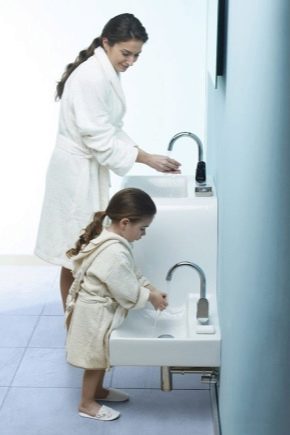
Competent arrangement of the bathroom is a guarantee of comfortable use of plumbing, therefore, in the bathroom, not only the aesthetics of the sink, toilet bowl and bathtub are of fundamental importance, but also their location. Special attention should be paid to such a question as the height of the sink attachment. This is especially true in large houses with children of different ages, because all household members have different heights. It is quite difficult to calculate at what level to hang the installation in such a way that it is comfortable for both adults to wash their face and for babies to brush their teeth without problems.
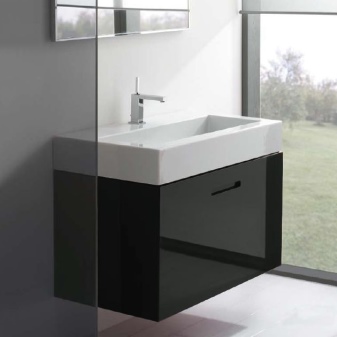
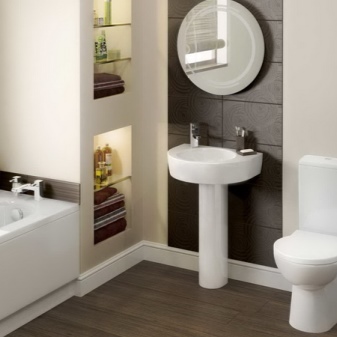
Standards according to SNiP
Even in the era of the USSR, all kinds of standards, GOSTs and SNiPs were developed, regulating the height of the installation of plumbing. The standard clearly prescribed where the toilet should be placed, where the hydrobox is and at what distance from the floor to fix the washbasin.
The estimated height of the sink reflects such an arrangement of the device in which its operation will be as comfortable as possible for a person.
In the Soviet Union, numerous studies were carried out, which led to the development of uniform standards for the installation of sanitary equipment in residential premises. Many years of studying the problem and careful study of all medical and anthropometric parameters made it possible to calculate what height of the washbasin would be most convenient. The calculation of this parameter was based on the average height of a person.
It has been experimentally established that for maximum comfort washbasins are set at the level:
- for a woman - 80–92 cm;
- for a man - 80-102 cm.


Based on this calculation, SNiP 3.05.01 was registered back in 1985, according to which the optimal height of the washbasin attachment should be 85 cm, while a deviation of +/- 2 cm was allowed.This standard is still used today by domestic and foreign manufacturers of sanitary ware. that is why, in most cases, shells with a height of 83–87 cm are produced.
Important! In recent years, the indicator of the average height of a person has a tendency to increase, today it is higher than 30 years ago, therefore, the corresponding standard is slowly but surely losing its significance. If all users are tall, then it is better to set the product slightly higher than the recommended values - by 95–100 cm. In this case, you will not have to bend too much while taking hygiene procedures.
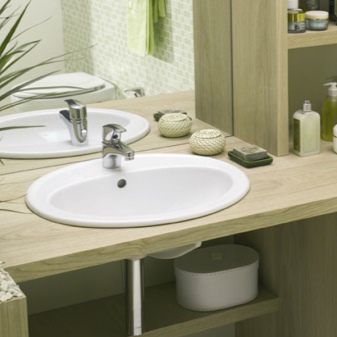

It is worth noting that SNiPs in this case are advisory, not mandatory. A change in the mounting height of the structure is not considered a redevelopment, therefore, separate approvals for changing the distance are not required. However, upon completion of the work, you should contact the management company so that its representatives make sure that increasing or decreasing the height of the sink does not in any way affect the functionality of the general water supply and drainage system in the apartment building. In the case of private housing construction, this is not required either. Each homeowner is free to equip a bathroom at his own discretion.
It is worth noting that if a decision was made not only to change the installation height, but also to move it outside the boundaries of the toilet, this will already refer to redevelopment actions, if they are carried out unauthorized, then a fine will be threatened for these actions.

Optimal: how to find?
It is quite simple to calculate what distance the shell will be correct. For this you only need:
- calculate the distance at which the elbows of the residents of an apartment or house are located;
- subtract about 8 cm from the obtained value;
- subtract the depth of the shell itself from the obtained indicator.
The resulting difference will be approximately equal to the most comfortable installation height.
To date, the average value is presented.

Men and women:
- for men - 94-102 cm;
- for women - 81–93 cm.
Children:
- adolescents - 65–80 cm;
- children - 40-60 cm.
By the way, in kindergartens they strictly adhere to the standards for the installation of washbasins, they are equal to the following values:
- for nursery groups - 40cm;
- for preschool groups of kindergartens - 50cm;
- for primary school - 55-60 cm;
- for high school - 65-85 cm.

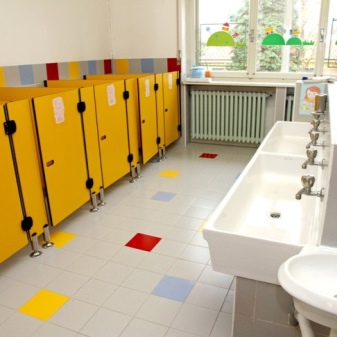
Compromise
Unfortunately, the standard area of toilets in multi-storey buildings does not leave the opportunity to install two or more sinks for younger family members, and there is no point in this for obvious reasons - children grow up, their growth increases, which means that the washbasin must constantly move.
Height-adjustable washbasins are ideal solutions, but this is costly and difficult to install. In practice, such plumbing is rarely used.
That is why you should choose a compromise solution that will allow all family members to tidy themselves up - from toddlers to adults. If the family is home to men (the optimal sink height should be 90-102 cm) and women (82-93 cm height), then it is worth hanging the sink at a height of 86 to 93 cm - this will allow each household member to perform hygiene procedures without any problems.
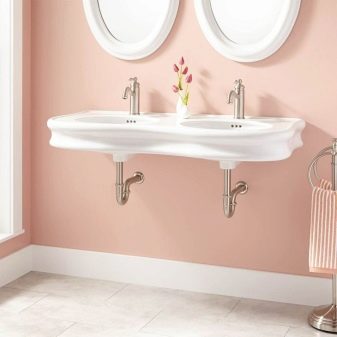

The situation is more complicated when there are children in the house. Many people try to install sinks below the recommended level for an adult. This approach is fundamentally wrong. Parents will be forced to constantly bend their backs, and this increases the load on the spine and leads to health problems. Therefore, the product should be installed at an "adult" height, and for the child to purchase special supports, with which he can rise to the height. The stand will allow your baby to wash and brush his teeth comfortably.

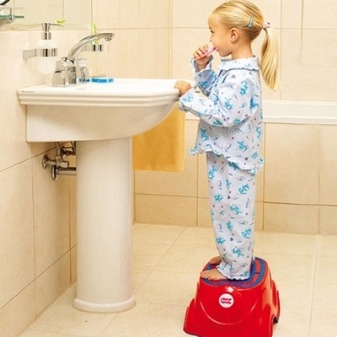
Types and dimensions of washbasins
Plumbing manufacturers today offer the widest selection of washbasin models, which differ in material of manufacture, height, shape and even capacity.
"Tulip"
This is a washbasin, which has the shape of a blossoming flower, located on a thin stem. In many cases, such items are made of ceramics, but glass or metal models are not uncommon. The bowl is made in the shape of petals, complemented by a pedestal, which performs two important functions: it serves as a strong support for the bowl and masks the inputs and outputs water inside the "stem", making the bathroom look more attractive and stylish. In such models, the base can either be integral with the bowl, or be sold separately as a set.


Such a sink is adjustable in height, so it is widely used in large families. However, its cost is appropriate - the price of a "tulip" is several times higher than the cost of similar products of other modifications. Not every Russian family can afford such an expensive attribute, so the products are not in great demand and are not sold in every construction supermarket.


A variety of "tulips" is considered a model with a semi-pedestal.In them, the base does not reach the floor level, but is placed at the required height, thanks to this feature, users have the opportunity to more ergonomically use the space under the bowl.

Suspended
The sink is usually installed in a small bathroom, since it saves an already small bathroom space.


Sink with cabinet
It looks like a bowl cut into the cabinet, where it is located. It does not seem realistic to adjust such models in height, therefore, it is better to determine the size of the dresser-stand at the stage of planning work.
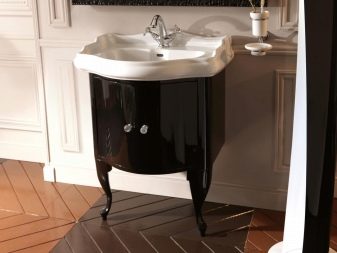

Traditionally, washbasins are made from ceramics, glass, stone or metal. Each of them has its own advantages and disadvantages.
Glass sinks
They are stylish and modern high-tech models that look great with chrome surfaces.
The advantages of the material include the following features:
- attractive design;
- resistance to high and low temperatures;
- light weight;
- glass is not afraid of brilliant green, red wine, fucorcin, iodine and other coloring liquids;
- can be cleaned with any standard detergents.


Among the shortcomings, the following should be noted:
- high price;
- fragility, low resistance to mechanical damage.
In addition, drips and water droplets are more visible on a glass surface than on any other.

Faience or porcelain
These are ceramic sinks, which outwardly are almost indistinguishable from each other. However, porcelain is a better and more durable material, it retains its unchanged appearance over the years, while traces of water and other liquids appear on earthenware over time.
In general, ceramic sinks have such advantages as:
- aesthetic design;
- resistance to high temperatures;
- resistance to all types of cleaning agents, including abrasive;
- noiselessness in contact with gushing water jets.


The disadvantages are more inherent in faience models. They lose color over time and can become covered with a fine mesh of cracks, and are also heavier than metal or glass. The disadvantages of porcelain washbasins include their high cost.
Metal
Such shells were common in earlier years, when they were made of steel. Today, the choice of models is not limited to stainless steel. Plumbing is often made from brass, cast iron and bronze. There are also bronze and even gold items. Metal washbasins have a long service life, they retain their aesthetic appearance for several decades. They are resistant to dirt and can be easily cleaned with any detergent (except abrasive).



A big plus is the low price - this only applies to steel installations. Models made from more expensive metals, as a rule, are produced exclusively and are very expensive. Of the minuses, we can note the noise when in contact with water. As for the dimensions, here the choice of modifications is quite wide. In the assortment list of leading manufacturers of sanitary ware, there are models with a width of 35 to 100 cm, sometimes even more. The optimal parameter is 50–70 cm.
Mounting options: interconnection
The distance from the floor, on which the sink is mounted, very often directly depends on the model of the sink. Sinks of different types differ in their operational parameters and method of attachment to the surface.

Overhead washbasins
Such products are attached to any flat tabletop. The product benefits include the following features:
- versatility - the sink can be installed in absolutely any place in the bathroom and at any height;
- ergonomics - the place under the countertop can be used to store household items;
- easy to install - holes are drilled in the worktop through which pipes and hoses pass.


Mortise
These models are a bit like overhead models because they also require a solid, flat surface to mount. The difference lies in the way of fastening. If the overhead models are mounted on the tabletop, then the mortise models are mounted directly into it, which allows them to be placed at the same level with it, to be slightly higher or slightly lower than it.
The advantage of the model is mobility, since such a sink can be installed both in the center of the surface and slightly to the side. Installation of the installation is quite simple, but it has several nuances, namely, it requires accuracy and utmost precision. It is very important to cut a hole in the countertop, which will exactly match the dimensions of the sink, and after installation, it is necessary to treat the joints with a sealant, which will prevent water from dripping in the future.

Console
Console models are also called suspended. Already from the name it becomes obvious that they should be hung directly on the bathroom wall using brackets or self-tapping screws. The latter can be of the following types:
- monolithic - have a T-shape, are made of cast iron and are characterized by strengthening the base;
- girth brackets look like metal frames into which bowls are inserted directly. Such modifications are considered to be the most stable;
- the "frame" bracket is outwardly similar to the previous varieties, but differs in nodes. In this case, the models are sliding, which allows you to change their size.


The modern industry produces sinks in a wide variety of configurations. That is why, when choosing the installation method, all the technical and physical parameters of the installation and the dimensions of the loads on the fasteners should be taken into account. For example, earthenware sinks are heavy and powerful in size. These features must be taken into account when calculating the fastening method.

Metrics for elements
There are regulations that govern the location of the sink in relation to other bathroom furnishings. Of course, the washbasin area is the most basic area of the bathroom. This is due to the fact that in typical high-rise buildings, rooms for receiving hygiene procedures, as a rule, are small in size, so the sink is installed first, and only then it is planned to place all the main elements: a bath or a hydrobox, a cabinet or a stylish machine, if possible.
By the way, some models of washing machines allow them to fit under the sink. However, in such cases, it is worth taking into account the fact that there must certainly be a gap between the two devices, otherwise the vibrations of the unit can damage the washbasin, cause chips and cracks, and also spoil its own thin plastic coating. For example, the height of the most compact washing machine is 71 cm, in which case the height of the washbasin must be at least 90 cm.


Mirror
Almost every bathroom has a mirror, as it represents a single interior ensemble with a sink, being its integral part. Functionally, it can be an independent element or part of a wall cabinet. In any case, the specified height standards should be adhered to when installing the mirror.
The distance from the floor to the mirror should be approximately 120-135 cm, while it should be located at a distance of at least 20 cm from the washbasin. If you install it higher, then the viewing angle will be inconvenient for the inhabitants of the apartments, and if you hang it below, on a mirror surface splashes of water will constantly fall.



Water sockets
Liquid entering the socket will inevitably lead to big problems. At best, this is fraught with a short circuit, at worst - a burnout of the wiring and even the occurrence of a fire hazard. That is why any sockets and electrical appliances should be placed at a distance of at least 60 cm from the water source.

Cupboard
The cabinet in the bathroom can be equipped in two ways: either install it under the bowl, if the design allows it, or hang it over the washbasin. In the first case, there are no problems with distance. The only thing to take into account is that the height of the cabinet should correspond to the distance from the floor to the bowl with a small gap. But if there is a desire to place shelves above the washbasin, then it is optimal to do this at a height of 130–135 cm. In this case, it will be easy to reach them, and splashes will not fall on the surface of the cabinet.


As for other elements of the bathroom interior, the top recommended parameters are as follows:
- It is best to place towel hooks at a distance of 60–70 cm from sinks. It should be easy to reach them even with closed eyes;
- a shelf for toothbrushes and soap dishes are mounted about 30–40 cm from the sink.
And of course, you need to plan well the distance between the sink and the toilet. It should be at least 25 cm. And it is best to increase this distance. The same standard applies to bidets. If the sink is located in a niche, then the length from one edge to the other should be at least 90 cm, otherwise it will be inconvenient and uncomfortable to wash.
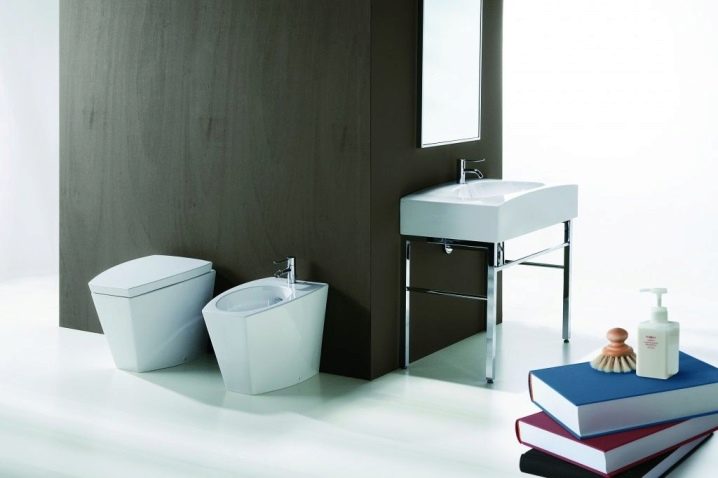
Selection and installation: tips
It is worth adhering to several recommendations from experts that will help make the bathroom more ergonomic, functional and stylish.
- It is recommended to think over the general arrangement of all items in advance, draw up a plan-diagram listing all sizes and modifications.
- When shopping and selecting a suitable model, you should focus on the method of fastening, because it must be combined with plumbing elements.
- The choice of mixer plays an important role. It is optimal if it is bought at the same time as the sink, since the product may have special holes for it or be absolutely deaf.

- Tulip washbasins come with a traditional length plinth. However, it can be resized if desired. To do this, the base is simply cut to the desired length and installed on any stable stand.
- When installing sanitary fittings, it is important to take into account the length between the siphon and the drain system. If it is located lower, then the operation of the washbasins will cause serious problems in general.
- When installing the washbasin, it is worth using a level, while it is better to give preference to laser tools, since they allow you to carry out all work in a higher quality.

The correct choice of sinks and professional installation of plumbing is a guarantee that the installation will serve its owners for many years.
For information on how to choose a sink for the bathroom, see the next video.













The comment was sent successfully.